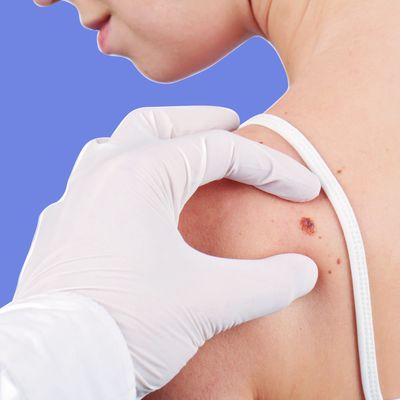
Last week I went to a dermatologist I found on ZocDoc for my annual skin cancer screening, something I’ve been doing for about eight years. For the first few I still lived in Minnesota, and went to the same dermatologist year after year, which is ideal, because they get to know your freckles and if/how they change. It was that dermatologist who first informed me I had a “precancerous” mole on my scalp, and would need it removed, resulting in a pinkie-print-size crater on my hairline. They told me the hair would grow back; it did not. I switched which side I part my hair on.
As a result of the pre-cancer, I was prescribed a lifetime of annual skin cancer screenings. Each appointment feels a little like Russian Roulette. The first follow-up was fine; the second resulted in the discovery of more pre-cancer, removed from the back of my calf. I moved to New York and had a string of clear screenings. Then, last week my latest dermatologist told me she wanted to biopsy the mole in the middle of my face, so familiar to me I’d forgotten it was there. She asked me if I’d always had it, and I was alarmed to realize I didn’t know.
But I’d notice if it had cropped up in the last few months, right? I didn’t fully trust myself to know, so I let her slice the top of it off. That part was fine — it’s the two numbing shots to the face I didn’t care for. Well, that and the spontaneous bleeding it did over the next 24 hours.
Could I have escaped the anesthetic shots if I’d paid better attention to my own face? Am I still on the right track with the annual screening rule? Hoping for some answers (and secretly hoping that she would praise me for my perfect attendance), I got in touch with Mary Stevenson, a dermatologist and micrographic surgeon at NYU Langone with some questions about skin cancer screenings: who needs them, how often, and what we should do between them.
Everyone should get a full skin screening at least once.
In order to determine how often you need to visit your dermatologist, you need to … see your dermatologist. “Get a skin check head to toe, and then decide with the dermatologist how often you should be screening,” says Stevenson. This is especially true if you have any of the known skin cancer risk factors: lots of moles; a family history of skin cancer; fair skin prone to sunburn; prior or current tanning bed use. Bad news for anyone who grew up during the early-aughts tanning bed craze: even one indoor tanning session can significantly increase the risk of developing skin cancer (melanoma by 20 percent, squamous cell carcinoma by 67 percent, and basal cell carcinoma by 29 percent).
But even if you don’t have any of the risk factors, it’s worth seeing your dermatologist to set a personal baseline, says Stevenson. “Sometimes something you’re not aware of is something that might be suspicious to someone else,” she adds. And while fairer-skinned people are more prone to skin cancer, black patients have the worst skin cancer survival rates, likely for a number of reasons, one being that dermatologists aren’t trained to spot cancer on black skin.
People who’ve had atypical moles should probably get two screenings a year, at least.
All this time I’ve felt smug for nothing. Given my history of atypical moles, my fair skin, and my shameful half-dozen tanning bed visits circa 2006, Stevenson says that if I were her patient, she’d tell me to get screened twice a year. While she concedes that the difference between six months and a year is unlikely to be “a game changer,” it’s a case of better safe than sorry. “If you have a personal history of many atypical moles, especially if you’re monitoring a lot of lesions [from prior biopsies], I find that laying eyes on that patient twice a year is a little bit better,” says Stevenson.
Patients who’ve had basal cell or squamous cell carcinoma (the two most common types of skin cancer) should also be screened twice a year, says Stevenson, while patients who’ve had melanoma (the third most common, and most aggressive, form of skin cancer) should be seen every three months for two years, after which point they can begin to see their dermatologists less frequently.
You should be screening your own skin, too.
Speaking from direct and fairly painful experience here, it’s worth knowing your own moles well — a dermatologist might ask how long you’ve had a mole before making the decision to take a biopsy. It’s not that a mole you’ve had for years can’t become a problem, but if you’ve had it for ages, and it hasn’t changed, it’s less likely.
To better familiarize yourself with your moles, and to help prevent skin cancer between dermatologist screenings, Stevenson recommends getting naked in front of the mirror once a month — have someone else check your back, or hold up one mirror to see your back in the other, she says. Look out for the “ABCDE’s” of skin cancer: asymmetry, irregular border, uneven color, diameter larger than a pea, and evolving. If you notice any of these signs, have your dermatologist take a look at it. Hopefully it will be nothing, and you can go home feeling healthy and superior.


